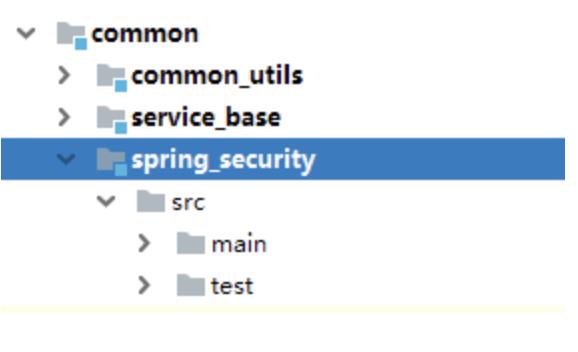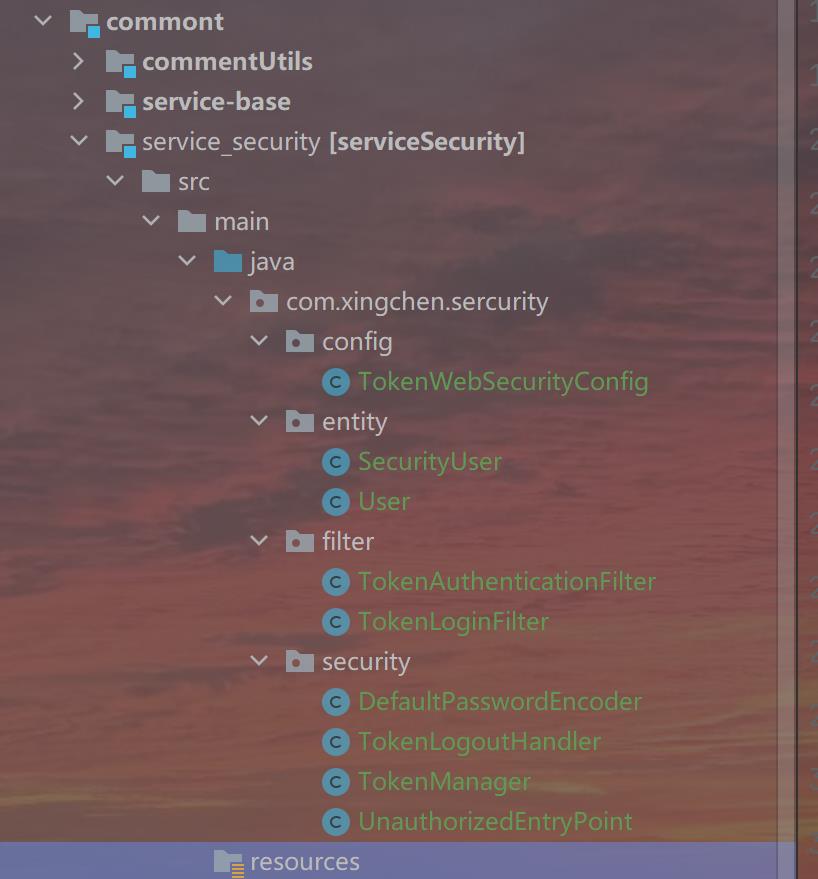SpringSecurity安全框架
Posted 林寻星辰
tags:
篇首语:本文由小常识网(cha138.com)小编为大家整理,主要介绍了SpringSecurity安全框架相关的知识,希望对你有一定的参考价值。
目录
(1)DefaultPasswordEncoder:密码处理的方法
(4)UnauthorizedEntryPoint:未授权统一处理
一、Spring Security介绍
1、框架介绍
Spring 是一个非常流行和成功的 Java 应用开发框架。Spring Security 基于 Spring 框架,提供了一套 Web 应用安全性的完整解决方案。一般来说,Web 应用的安全性包括用户认证(Authentication)和用户授权(Authorization)两个部分。
(1)用户认证指的是:验证某个用户是否为系统中的合法主体,也就是说用户能否访问该系统。用户认证一般要求用户提供用户名和密码。系统通过校验用户名和密码来完成认证过程。
(2)用户授权指的是验证某个用户是否有权限执行某个操作。在一个系统中,不同用户所具有的权限是不同的。比如对一个文件来说,有的用户只能进行读取,而有的用户可以进行修改。一般来说,系统会为不同的用户分配不同的角色,而每个角色则对应一系列的权限。
Spring Security其实就是用filter,多请求的路径进行过滤。
(1)如果是基于Session,那么Spring-security会对cookie里的sessionid进行解析,找到服务器存储的sesion信息,然后判断当前用户是否符合请求的要求。
(2)如果是token,则是解析出token,然后将当前请求加入到Spring-security管理的权限信息中去
2、认证与授权实现思路
如果系统的模块众多,每个模块都需要就行授权与认证,所以我们选择基于token的形式进行授权与认证,用户根据用户名密码认证成功,然后获取当前用户角色的一系列权限值,并以用户名为key,权限列表为value的形式存入redis缓存中,根据用户名相关信息生成token返回,浏览器将token记录到cookie中,每次调用api接口都默认将token携带到header请求头中,Spring-security解析header头获取token信息,解析token获取当前用户名,根据用户名就可以从redis中获取权限列表,这样Spring-security就能够判断当前请求是否有权限访问
二、整合Spring Security
1、在common下创建spring_security模块

2、在spring_security引入相关依赖
<properties>
<maven.compiler.source>8</maven.compiler.source>
<maven.compiler.target>8</maven.compiler.target>
</properties>
<dependencies>
<dependency>
<groupId>com.xingchen</groupId>
<artifactId>commentUtils</artifactId>
<version>0.0.1-SNAPSHOT</version>
</dependency>
<!-- Spring Security依赖 -->
<dependency>
<groupId>org.springframework.boot</groupId>
<artifactId>spring-boot-starter-security</artifactId>
</dependency>
<dependency>
<groupId>io.jsonwebtoken</groupId>
<artifactId>jjwt</artifactId>
</dependency>
</dependencies>
3.代码结构说明:

4、创建spring security核心配置类
Spring Security的核心配置就是继承WebSecurityConfigurerAdapter并注解@EnableWebSecurity的配置。
这个配置指明了用户名密码的处理方式、请求路径的开合、登录登出控制等和安全相关的配置
package com.xingchen.sercurity.config;
import com.xingchen.sercurity.filter.TokenAuthenticationFilter;
import com.xingchen.sercurity.filter.TokenLoginFilter;
import com.xingchen.sercurity.security.DefaultPasswordEncoder;
import com.xingchen.sercurity.security.TokenLogoutHandler;
import com.xingchen.sercurity.security.TokenManager;
import com.xingchen.sercurity.security.UnauthorizedEntryPoint;
import org.springframework.beans.factory.annotation.Autowired;
import org.springframework.context.annotation.Configuration;
import org.springframework.data.redis.core.RedisTemplate;
import org.springframework.security.config.annotation.authentication.builders.AuthenticationManagerBuilder;
import org.springframework.security.config.annotation.method.configuration.EnableGlobalMethodSecurity;
import org.springframework.security.config.annotation.web.builders.HttpSecurity;
import org.springframework.security.config.annotation.web.builders.WebSecurity;
import org.springframework.security.config.annotation.web.configuration.EnableWebSecurity;
import org.springframework.security.config.annotation.web.configuration.WebSecurityConfigurerAdapter;
import org.springframework.security.core.userdetails.UserDetailsService;
/**
* @author xing'chen
*/
@Configuration
@EnableWebSecurity
@EnableGlobalMethodSecurity(prePostEnabled = true)
public class TokenWebSecurityConfig extends WebSecurityConfigurerAdapter
private UserDetailsService userDetailsService;
private TokenManager tokenManager;
private DefaultPasswordEncoder defaultPasswordEncoder;
private RedisTemplate redisTemplate;
@Autowired
public TokenWebSecurityConfig(UserDetailsService userDetailsService, DefaultPasswordEncoder defaultPasswordEncoder,
TokenManager tokenManager, RedisTemplate redisTemplate)
this.userDetailsService = userDetailsService;
this.defaultPasswordEncoder = defaultPasswordEncoder;
this.tokenManager = tokenManager;
this.redisTemplate = redisTemplate;
/**
* 配置设置
* @param http
* @throws Exception
*/
@Override
protected void configure(HttpSecurity http) throws Exception
http.exceptionHandling()
.authenticationEntryPoint(new UnauthorizedEntryPoint())
.and().csrf().disable()
.authorizeRequests()
.anyRequest().authenticated()
.and().logout().logoutUrl("/admin/acl/index/logout")
.addLogoutHandler(new TokenLogoutHandler(tokenManager,redisTemplate)).and()
.addFilter(new TokenLoginFilter(authenticationManager(), tokenManager, redisTemplate))
.addFilter(new TokenAuthenticationFilter(authenticationManager(), tokenManager, redisTemplate)).httpBasic();
/**
* 密码处理
* @param auth
* @throws Exception
*/
@Override
public void configure(AuthenticationManagerBuilder auth) throws Exception
auth.userDetailsService(userDetailsService).passwordEncoder(defaultPasswordEncoder);
/**
* 配置哪些请求不拦截
* @param web
* @throws Exception
*/
@Override
public void configure(WebSecurity web) throws Exception
// web.ignoring().antMatchers("/api/**",
// "/swagger-resources/**", "/webjars/**", "/v2/**", "/swagger-ui.html/**"
// );
web.ignoring().antMatchers("/*/**"
);
5、创建认证授权相关的工具类
(1)DefaultPasswordEncoder:密码处理的方法
package com.xingchen.sercurity.security;
import com.xingchen.utils.MD5;
import org.springframework.security.crypto.password.PasswordEncoder;
import org.springframework.stereotype.Component;
/**
* @author xing'chen
*
* * t密码的处理方法类型
*/
@Component
public class DefaultPasswordEncoder implements PasswordEncoder
public DefaultPasswordEncoder()
this(-1);
/**
* @param strength
* the log rounds to use, between 4 and 31
*/
public DefaultPasswordEncoder(int strength)
@Override
public String encode(CharSequence rawPassword)
return MD5.encrypt(rawPassword.toString());
@Override
public boolean matches(CharSequence rawPassword, String encodedPassword)
return encodedPassword.equals(MD5.encrypt(rawPassword.toString()));
(2)TokenManager:token操作的工具类
package com.xingchen.sercurity.security;
import io.jsonwebtoken.CompressionCodecs;
import io.jsonwebtoken.Jwts;
import io.jsonwebtoken.SignatureAlgorithm;
import org.springframework.stereotype.Component;
import java.util.Date;
/**
* @author xing'chen
* * token管理
*/
@Component
public class TokenManager
private long tokenExpiration = 24*60*60*1000;
private String tokenSignKey = "123456";
public String createToken(String username)
String token = Jwts.builder().setSubject(username)
.setExpiration(new Date(System.currentTimeMillis() + tokenExpiration))
.signWith(SignatureAlgorithm.HS512, tokenSignKey).compressWith(CompressionCodecs.GZIP).compact();
return token;
public String getUserFromToken(String token)
String user = Jwts.parser().setSigningKey(tokenSignKey).parseClaimsJws(token).getBody().getSubject();
return user;
public void removeToken(String token)
//jwttoken无需删除,客户端扔掉即可。
(3)TokenLogoutHandler:退出实现
package com.xingchen.sercurity.security;
import com.xingchen.utils.*;
import org.springframework.data.redis.core.RedisTemplate;
import org.springframework.security.core.Authentication;
import org.springframework.security.web.authentication.logout.LogoutHandler;
import javax.servlet.http.HttpServletRequest;
import javax.servlet.http.HttpServletResponse;
/**
* @author xing'chen
* * 登出业务逻辑类
*/
public class TokenLogoutHandler implements LogoutHandler
private TokenManager tokenManager;
private RedisTemplate redisTemplate;
public TokenLogoutHandler(TokenManager tokenManager, RedisTemplate redisTemplate)
this.tokenManager = tokenManager;
this.redisTemplate = redisTemplate;
@Override
public void logout(HttpServletRequest request, HttpServletResponse response, Authentication authentication)
String token = request.getHeader("token");
if (token != null)
tokenManager.removeToken(token);
//清空当前用户缓存中的权限数据
String userName = tokenManager.getUserFromToken(token);
redisTemplate.delete(userName);
ResponseUtil.out(response, R.ok());
(4)UnauthorizedEntryPoint:未授权统一处理
package com.xingchen.sercurity.security;
import com.xingchen.utils.R;
import com.xingchen.utils.ResponseUtil;
import org.springframework.security.core.AuthenticationException;
import org.springframework.security.web.AuthenticationEntryPoint;
import javax.servlet.ServletException;
import javax.servlet.http.HttpServletRequest;
import javax.servlet.http.HttpServletResponse;
import java.io.IOException;
/**
* @author xing'chen
*
* * 未授权的统一处理方式
*/
public class UnauthorizedEntryPoint implements AuthenticationEntryPoint
@Override
public void commence(HttpServletRequest request, HttpServletResponse response,
AuthenticationException authException) throws IOException, ServletException
ResponseUtil.out(response, R.error());
6、创建认证授权实体类
(1)SecutityUser
package com.xingchen.sercurity.entity;
import lombok.Data;
import lombok.extern.slf4j.Slf4j;
import org.springframework.security.core.GrantedAuthority;
import org.springframework.security.core.authority.SimpleGrantedAuthority;
import org.springframework.security.core.userdetails.UserDetails;
import org.springframework.util.StringUtils;
import java.util.ArrayList;
import java.util.Collection;
import java.util.List;
/**
* @author xingchen
* * 安全认证用户详情信息
*/
@Data
@Slf4j
public class SecurityUser implements UserDetails
//当前登录用户
private transient User currentUserInfo;
//当前权限
private List<String> permissionValueList;
public SecurityUser()
public SecurityUser(User user)
if (user != null)
this.currentUserInfo = user;
@Override
public Collection<? extends GrantedAuthority> getAuthorities()
Collection<GrantedAuthority> authorities = new ArrayList<>();
for(String permissionValue : permissionValueList)
if(StringUtils.isEmpty(permissionValue)) continue;
SimpleGrantedAuthority authority = new SimpleGrantedAuthority(permissionValue);
authorities.add(authority);
return authorities;
@Override
public String getPassword()
return currentUserInfo.getPassword();
@Override
public String getUsername()
return currentUserInfo.getUsername();
@Override
public boolean isAccountNonExpired()
return true;
@Override
public boolean isAccountNonLocked()
return true;
@Override
public boolean isCredentialsNonExpired()
return true;
@Override
public boolean isEnabled()
return true;
(2)User
package com.xingchen.sercurity.entity;
import io.swagger.annotations.ApiModel;
import io.swagger.annotations.ApiModelProperty;
import lombok.Data;
import java.io.Serializable;
/**
* @author xing'chen
*
* * 用户实体类
*/
@Data
@ApiModel(description = "用户实体类")
public class User implements Serializable
private static final long serialVersionUID = 1L;
@ApiModelProperty(value = "微信openid")
private String username;
@ApiModelProperty(value = "密码")
private String password;
@ApiModelProperty(value = "昵称")
private String nickName;
@ApiModelProperty(value = "用户头像")
private String salt;
@ApiModelProperty(value = "用户签名")
private String token;
7、创建认证和授权的filter
(1)TokenLoginFilter:认证的filter
package com.xingchen.sercurity.filter;
import com.fasterxml.jackson.databind.ObjectMapper;
import com.xingchen.sercurity.entity.SecurityUser;
import com.xingchen.sercurity.entity.User;
import com.xingchen.sercurity.security.TokenManager;
import com.xingchen.utils.R;
import com.xingchen.utils.ResponseUtil;
import org.springframework.data.redis.core.RedisTemplate;
import org.springframework.security.authentication.AuthenticationManager;
import org.springframework.security.authentication.UsernamePasswordAuthenticationToken;
import org.springframework.security.core.Authentication;
import org.springframework.security.core.AuthenticationException;
import org.springframework.security.web.authentication.UsernamePasswordAuthenticationFilter;
import org.springframework.security.web.util.matcher.AntPathRequestMatcher;
import javax.servlet.FilterChain;
import javax.servlet.ServletException;
import javax.servlet.http.HttpServletRequest;
import javax.servlet.http.HttpServletResponse;
import java.io.IOException;
import java.util.ArrayList;
/**
* @author xingchen
* * 登录过滤器,继承UsernamePasswordAuthenticationFilter,对用户名密码进行登录校验
*/
public class TokenLoginFilter extends UsernamePasswordAuthenticationFilter
private AuthenticationManager authenticationManager;
private TokenManager tokenManager;
private RedisTemplate redisTemplate;
public TokenLoginFilter(AuthenticationManager authenticationManager, TokenManager tokenManager, RedisTemplate redisTemplate)
this.authenticationManager = authenticationManager;
this.tokenManager = tokenManager;
this.redisTemplate = redisTemplate;
this.setPostOnly(false);
this.setRequiresAuthenticationRequestMatcher(new AntPathRequestMatcher("/admin/acl/login","POST"));
@Override
public Authentication attemptAuthentication(HttpServletRequest req, HttpServletResponse res)
throws AuthenticationException
try
User user = new ObjectMapper().readValue(req.getInputStream(), User.class);
return authenticationManager.authenticate(new UsernamePasswordAuthenticationToken(user.getUsername(), user.getPassword(), new ArrayList<>()));
catch (IOException e)
throw new RuntimeException(e);
/**
* 登录成功
* @param req
* @param res
* @param chain
* @param auth
* @throws IOException
* @throws ServletException
*/
@Override
protected void successfulAuthentication(HttpServletRequest req, HttpServletResponse res, FilterChain chain,
Authentication auth) throws IOException, ServletException
SecurityUser user = (SecurityUser) auth.getPrincipal();
String token = tokenManager.createToken(user.getCurrentUserInfo().getUsername());
redisTemplate.opsForValue().set(user.getCurrentUserInfo().getUsername(), user.getPermissionValueList());
ResponseUtil.out(res, R.ok().data("token", token));
/**
* 登录失败
* @param request
* @param response
* @param e
* @throws IOException
* @throws ServletException
*/
@Override
protected void unsuccessfulAuthentication(HttpServletRequest request, HttpServletResponse response,
AuthenticationException e) throws IOException, ServletException
ResponseUtil.out(response, R.error());
(2)TokenAuthenticationFilter:
授权filter
package com.xingchen.sercurity.filter;
import com.xingchen.sercurity.security.TokenManager;
import com.xingchen.utils.R;
import com.xingchen.utils.ResponseUtil;
import org.springframework.data.redis.core.RedisTemplate;
import org.springframework.security.authentication.AuthenticationManager;
import org.springframework.security.authentication.UsernamePasswordAuthenticationToken;
import org.springframework.security.core.GrantedAuthority;
import org.springframework.security.core.authority.SimpleGrantedAuthority;
import org.springframework.security.core.context.SecurityContextHolder;
import org.springframework.security.web.authentication.www.BasicAuthenticationFilter;
import org.springframework.util.StringUtils;
import javax.servlet.FilterChain;
import javax.servlet.ServletException;
import javax.servlet.http.HttpServletRequest;
import javax.servlet.http.HttpServletResponse;
import java.io.IOException;
import java.util.ArrayList;
import java.util.Collection;
import java.util.List;
/**
* @author xingchen
* * 访问过滤器
*/
public class TokenAuthenticationFilter extends BasicAuthenticationFilter
private TokenManager tokenManager;
private RedisTemplate redisTemplate;
public TokenAuthenticationFilter(AuthenticationManager authManager, TokenManager tokenManager,RedisTemplate redisTemplate)
super(authManager);
this.tokenManager = tokenManager;
this.redisTemplate = redisTemplate;
@Override
protected void doFilterInternal(HttpServletRequest req, HttpServletResponse res, FilterChain chain)
throws IOException, ServletException
logger.info("================="+req.getRequestURI());
if(req.getRequestURI().indexOf("admin") == -1)
chain.doFilter(req, res);
return;
UsernamePasswordAuthenticationToken authentication = null;
try
authentication = getAuthentication(req);
catch (Exception e)
ResponseUtil.out(res, R.error());
if (authentication != null)
SecurityContextHolder.getContext().setAuthentication(authentication);
else
ResponseUtil.out(res, R.error());
chain.doFilter(req, res);
private UsernamePasswordAuthenticationToken getAuthentication(HttpServletRequest request)
// token置于header里
String token = request.getHeader("token");
if (token != null && !"".equals(token.trim()))
String userName = tokenManager.getUserFromToken(token);
List<String> permissionValueList = (List<String>) redisTemplate.opsForValue().get(userName);
Collection<GrantedAuthority> authorities = new ArrayList<>();
for(String permissionValue : permissionValueList)
if(StringUtils.isEmpty(permissionValue))
continue;
SimpleGrantedAuthority authority = new SimpleGrantedAuthority(permissionValue);
authorities.add(authority);
if (!StringUtils.isEmpty(userName))
return new UsernamePasswordAuthenticationToken(userName, token, authorities);
return null;
return null;
22SpringBoot 与安全框架SpringSecurity
1
以上是关于SpringSecurity安全框架的主要内容,如果未能解决你的问题,请参考以下文章